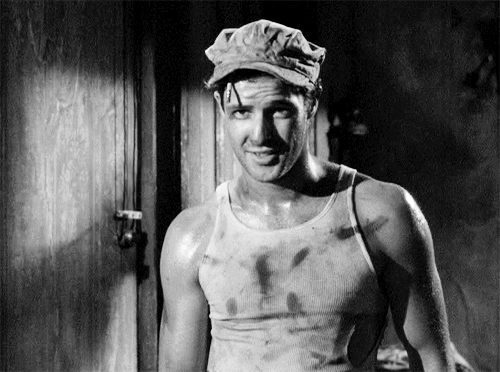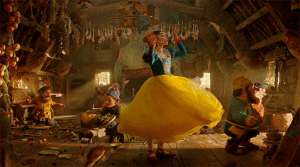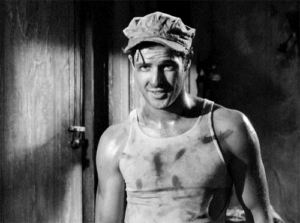A Streetcar Named Desire (1951)

…………………………………………………
A Streetcar Named Desire Movie Review
A Streetcar Named Desire is a 1951 drama film directed by Elia Kazan and starring Vivien Leigh and Marlon Brando. It’s a powerful film that is an undisputed classic.
………………………………………………….
“I have always depended on the kindness of strangers“
…………………………………………………..
…………………………………………………..
Disturbed Blanche DuBois moves in with her sister in New Orleans and is tormented by her brutish brother-in-law while her reality crumbles around her. Based on the titular stage play written by Tennessee Williams, this production brought most of the same players of the original version back and the result is a masterfully performed drama that is still impressive to observe. It’s no wonder that it almost got Oscar wins in all four acting categories and it deserved to win all four, but sadly the Best Actor Oscar proved to be elusive.
Yes, this is the type of film that is made or broken by its acting performances and it’s clear which of the two was the case here. Kim Hunter was wonderful in the role of Stella. Stella is this old-fashioned woman who is into aggressive and rugged men. The movie should be praised for actually delving into this psychology as it’s almost never discussed on the big screen. I really liked her character, who is by far the most sympathetic of the bunch. Her evident care for her sister was beautiful.
Karl Malden was also terrific as Mitch, the love interest of Blanche. He’s a big guy with a lot of heart and it’s difficult not to be endeared by his personality. Malden has always been a dependable Hollywood actor, but this is his only Oscar, and I am so glad that they gave it to him for this very well written and performed role.
Then we have Marlon Brando. This performance proved to be revolutionary as it brought realistic method acting to the industry. It was hugely influential and Brando is still fondly remembered for this turn. I do not appreciate that others do not get mentioned as much when this classic is discussed, but Brando was still undoubtedly magnetic as Stanley Kowalski, who is this very brutish, animalistic redneck-type character rarely seen in cinema of the time. How he moved like a big animal and how he exuded charisma and sex appeal was particularly impressive.
…………………………………………………..
…………………………………………………..
We should not forget Vivien Leigh’s contribution to this film when discussing it. She rightfully won an Oscar for her brilliant turn as Blanche DuBois, a Southern Belle who has a much more complicated past than it initially seems. Leigh’s acting style is more theatrical and melodramatic than the more grounded style of Brando, but this clash of styles entirely worked as the characters are so wildly different from each other. Leigh was so moving in a powerhouse performance. Blanche is the heart of the story and that ending was truly heartbreaking as we’d come to care for the poor woman. Her arc explored delusion versus reality so well and she’s such a layered character.
A Streetcar Named Desire features absolutely incredible dialogue as expected from Tennessee Williams. The “Stella!” line is of course iconic and so is the Blanche line about the kindness of strangers. That ending was pleasingly reminiscent of the final scene in ‘Sunset Boulevard’ in both its dialogue and the depiction of insanity. If there is one thing that I did not love here it has to be the implied rape. That was a bit unnecessary to me, but even that lent the movie even more urgency and realism.
Speaking of that realism, this was such an unusual production for Hollywood as it deals with very dark themes that we do not often see from that time period, themes that range from domestic abuse to rape to madness to nymphomania and all the way to the relationship between an adult and a minor. Most of these elements were excised from the original theatrical version, but thankfully the restored one brought all of those back for modern viewers.
Even the depiction of poor folk living in an impoverished part of New Orleans was exceptionally rare for the time. We also see the portrayal of the immigrant experience. All of these elements gave the movie the sort of authenticity that led to it being so timeless. The sweat on Brando’s arms and chest, the calls of Spanish-speaking sellers outside, the dusty streets, and the poker-playing ruffians all lent the film a rugged aesthetic unlike no other.
…………………………………………………..
…………………………………………………..
The cinematography is phenomenal and so is the elegant and atmospheric score. The costumes and sets are both superb. Elia Kazan’s directing was top-notch per usual. This is a technical achievement that elevated the movie beyond its stagey origins very successfully. It really should have gotten more Oscar wins out of its impressive 12 nominations.
Superbly performed by its incredible cast, A Streetcar Named Desire is an acting showcase from start to finish. Karl Malden was fantastic in such a strong role and Kim Hunter was also quite memorable. Marlon Brando delivered a very grounded and physically charged performance that is still iconic to this day while Vivien Leigh rightfully won an Oscar for her deeply emotional and complicated turn as the tragic Blanche. This movie has that typically outstanding Tennessee Williams dialogue, but it was elevated beyond its stagey origins to a very cinematic film thanks to its incredible cinematography, a superb score, and beautiful sets and costumes. But the main reason why this classic has stood the test of time lies in its raw depiction of characters’ emotions and in its groundbreaking for the time, honest treatment of very mature themes and situations. It’s a true masterpiece.
My Rating – 5











